Under the first successors of the Prophet Muhammad, a Muslim state was formed - the Arab Caliphate with its capital in Medina. It established itself throughout the Arabian Peninsula, and then began to fight to spread its influence in other lands.
By the middle of the VII century. the Arabs conquered Syria, Iraq, Palestine, Iran, Transcaucasia, in North Africa they subjugated Egypt, Libya (find these territories on the map).
His conquest became turning point in history and marks the expansion of the Caliphate in the Middle East and Africa. Arab expansion into the region was the birth of the world we know today. This expansion created one of the world's largest empires.
Prelude to the Arab conquest of Damascus
The two empires have been in constant conflict for decades and have not paid much attention to the growing threat. Their territorial conflicts and battles ended too late in 627 and left them completely unprepared for the coming. Meanwhile, the Prophet Muhammad successfully united the Arabs. By the time of his death, most of Arabia was already under a single religious and political authority. Although the passage of the Prophet was the cause of division in Islamic teaching, it was also the inspiration for the Arab conquest.
At the beginning of the VIII century. the Arabs, who by that time had created a powerful fleet, crossed the Strait of Gibraltar and invaded European territory. They defeated the Visigothic kingdom in Spain, and then headed north to the lands of the Franks. Their further advance was suspended after the Battle of Poitiers (732), where the Arab army was defeated by the Franks, led by Karl Martell. But practically the entire Iberian Peninsula fell under the rule of the Arabs. Here a caliphate was formed with the center in Cordoba, and after its collapse (in the 11th century), the Granada Emirate existed for several more centuries.
Abu Bakr, who at that time was elected as his successor by some of his followers, began his movement in his primary goals - the Sassanid Empire and the Byzantine Empire. Abu Bakr quickly and successfully crossed the path of conquest. The Persian province of Iraq became Arab dominion, and then the Arabs entered the Byzantine Empire. After the defeat of the Roman army and the capture of significant territories, they now stood in front of Damascus. Abu Bakr is supported by his able general Khalid ibn Walid.
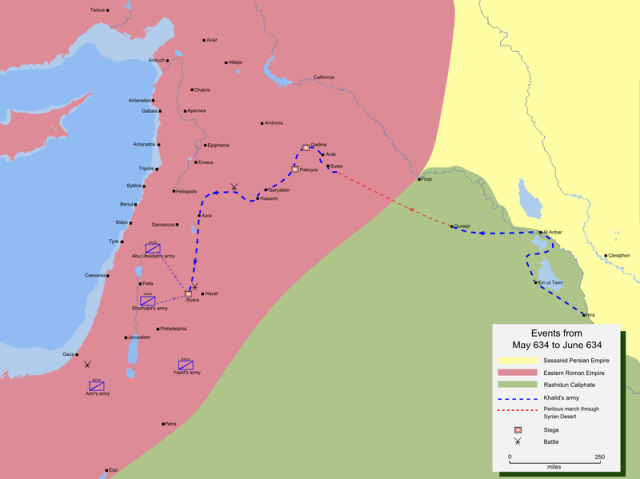
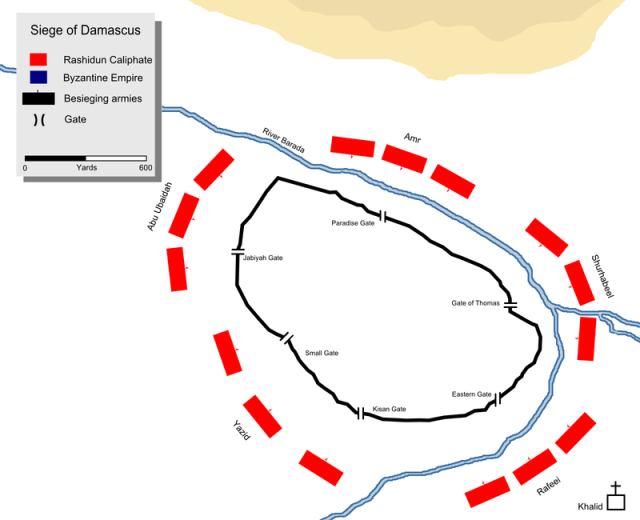
Khalid knew full well that his army did not have enough siege weapons to destroy the fortified Byzantine city, so he made another approach. The Arab conquerors surrounded the city on all sides and cut off all supplies and communications. The Arab tactic was simple - to starve in the city until they surrendered. All six gates in the city were heavily guarded and ordered to prevent any Byzantine force from reaching the city.
/ \ How are Arab warriors depicted? On what basis did you determine this?
The onslaught of the Arabs stunned the attacked peoples. Subsequently, historians wondered how a small group of tribes managed to conquer so much in a short time. ^ significant territories? Can
give some explanation. In-
First, the Bedouin Arabs, who made up the bulk of the army, were distinguished by great militancy and courage, as well as discipline (since relations in the tribe taught them to be unquestioningly obedient to their elders). Their cavalry units were fast, agile in battle. Secondly, the campaigns were carried out with the aim of spreading the religion, which every Muslim believed to be the only true one. Faith gave strength to the Arab soldiers.
His quick victory and quick cavalry allow him to return to the city before the defenders can organize any offensive. A week later, the commander of the Roman garrison in Damascus decided to break the line of the siege of Khalid. The offensive of the defenders took place in two subsequent waves and days, but without a victory. The commander himself, Thomas, was wounded by an arrow in his eyes.
Khalid saw this as an excellent opportunity to storm the city. Therefore, he personally led the charge at one of the gates. In the shortest possible time he will be able to enter the city. Thomas, desperate to save the city, approached Khalid's commanders. He convinced Khalid to spare the city because other Christians would quickly organize against the Muslim conquerors.
Wherein
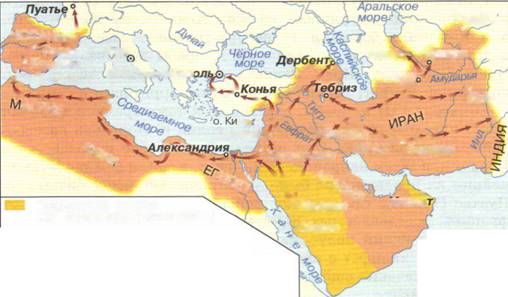
Arabian
Directions campaigns of conquest Arabs Territories conquered by Arabs by 750 g
Borders Arab Caliphate during its heyday (750)
the captured lands and values were considered the property not of individual soldiers, but of the Muslim community as a whole. For example, about one fifth of the spoils of war should have been transferred to fellow believers in need.
The commander convinced Khalid, and he agreed to occupy the city, but without killing local residents or the destruction of Christian churches, and let everyone who wants to leave the city unharmed. The so-called part was agreed on for three days, during which everyone decided whether to stay or leave. The moment those three days passed, Khalid made sure to get rid of the refugee convoy.
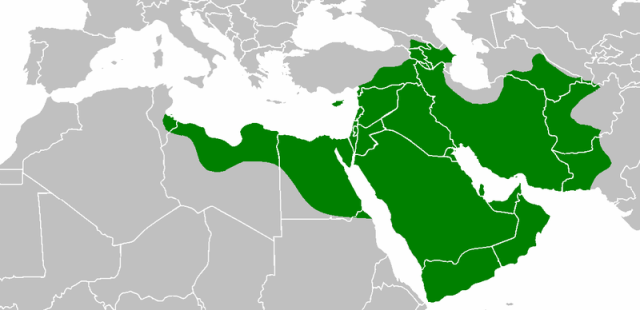
Damascus became the cultural center of the Islamic religion, which was first designated the capital of Syria and then the very capital of the mighty Umayyad Caliphate. It was used as a union Arab culture, language and the newly created Islamic religion. After the Battle of Yarmuk and the tactically great victory of Khalid against the Byzantine forces of Heraclius, the result of the conquest was clear.
Over time, the Arab army, which originally consisted of the militia, became hired. In it, detachments of the guards appeared - professional warriors (Mamluks), trained in accordance with the requirements of the most severe discipline from the boys of the Gentiles, bought on the slave market or forcibly taken out of their native lands.
Thus, in a little over a hundred years, tremendous changes have taken place in the life of the Arabs. From a group of scattered tribes, they turned into a people united by a single Islamic religion, a single political and spiritual power. They conquered vast territories in Asia, North Africa and created one of the largest states of their time - the Arab Caliphate.
The fall of Damascus served important point in the history of Islam. He united the Islamic religion in the region and spread it throughout the Middle East and Africa. Allowed the stabilization of the future powerful caliphate in order to gain an irresistible force and conquer the Persian Empire.
The Arab conquest infiltrated the lands they crossed with blood and precipitated the subsequent Islamic expansion for many centuries to come. By the year 750, Islamic expansion had already swept the entire Middle East, North Africa and parts of Asia. In less than 100 years, it has changed the future of the world.
Questions and tasks 1.
Tell us about the living conditions and occupations of the Arab tribes. 2.
When and how did Islam come about? What role did the prophet Muhammad play in this? 3.
Tell us about the Arab conquests using the map. 4.
Explain what changed in the life of Arabs with the advent of Islam. 5.
What was the peculiarity of the power of the Prophet Muhammad, and then of the Caliphs in Muslim society? 6.
The Arab conquest of the Persian Empire had a primary impact on him and the neighboring lands. In hindsight, the initial movements of the Arab conquerors across the lands of the Middle East settled the Islamic religion and the countries we now see on the map.
The easy fall of both empires was also due to the fact that they could not recognize the threat and considered it in a timely manner. During their wars with each other, the Byzantine and Sassanian empires constantly needed to rebuild their armies, since after each clash they suffered heavy losses. Probably one of the main reasons why the Arab conquest broke through their lands so easily and took them is precisely the decades of war between them.
What books, collections contain the most important provisions of Islam? Explain how they are relevant to the daily life of a Muslim (including today). 7.
Explain why the Arabs were able to subjugate such large areas.
Ready homework for workbook on the History of the 6th grade "History of the Middle Ages". E. A. Kryuchkova
Answers to tasks from § 9. The emergence of Islam. Arab Caliphate and its disintegration
Solving history homework with us can help you get good grades when your teacher checks your notebook.
While the Arab occupiers were highly motivated and strongly united, the land for which the two empires fought all along was scarce at all. There was no strong and consolidated power in any of the imperial territories captured by the Arabs. The rapidly expanding caliphate has become one of the most powerful forces in the Middle East.
In the context of only internal Egyptian history, this era was one in which Egypt discarded the legacy of the past in order to embrace a new language and a new religion - in other words, a new culture. While it is true that the past was by no means immediately and completely abandoned, and that many aspects of Egyptian life, especially rural life, remained practically unchanged, it is nevertheless clear that the civilization of Egypt differs sharply from the civilization of the previous Greco-Roman period and was transformed under the influence of Western occupation.
Task number 1.
Fill in outline map"The conquests of the Arabs in the 7th-8th centuries."
1. Paint over the territory of the Arab state, which arose around 630.
2. Sign on the map the names of the countries: Arabia, Egypt, Iran, as well as cities: Mecca, Medina, Damascus, Talas, Baghdad, Cordoba, Poitiers.
3. Color the arrows indicating the directions of the main conquest campaigns of the Arabs, mark the places and sign the dates of the most important battles (Note, on the map the battle places are marked with a cross and a number. The note below shows the dates and places of the marked battles).
4. Paint over the territories conquered by the Arabs by the year 750.
5. Mark the boundaries of the Arab Caliphate in 750.
6. Paint over the territories occupied by the Arabs after 750.
The numbers on the map indicate the places of the largest battles:
1.20 August 636. Battle of Yarmouk between Byzantines and Arabs;
2.December 2, 636. Battle of Qadisiyah between Persians and Arabs;
3.July 19, 711. Battle of Guadalete between Visigoths and Arabs;
4.717-718. Siege of Constantinople;
5.October 10, 732. Battle of Poitiers between Franks and Arabs;
6.July 751 Battle of Talas between the Tang Chinese army and the Arabs.
Therefore, the subsequent history of Egypt largely studies the processes by which the Egyptian Islamic civilization develops, in particular the processes of Arabization and Islamization. But limit Egyptian history internal events - to distort it, because during this entire period Egypt was part of a great world empire; and in this broader context, the history of Egypt is a testament to its long struggle to dominate the empire - a struggle that is not without parallels, of course, both in antiquity and in our time.
Period of Arab and Turkish governors
The sending of a military expedition to Egypt from the capital of the Caliphate took place in the second phase of the first Arab conquests. Prior to this, the conquests were directed against the lands on the northern borders of Arabia and were in the order of raids for plunder; they grew in scope and momentum, as did Persian — the two dominant political actors of the day — orchestrated resistance. By 635, the Arabs realized that to effectively counter this resistance, they must begin a systematic occupation of enemy territory, especially where the Byzantine army decided to stop Arab raids.
Task number 2.
Fill out the "Disintegration of the Caliphate" outline map.
1. Circle the borders of the Arab Caliphate in 750.
2. Sign the names on the map: Baghdad Caliphate, Cordoba Caliphate, Baghdad, Cordoba, Tigris, Euphrates, Nile.
3. Mark the boundaries of the states that emerged as a result of the collapse of the Arab Caliphate at the beginning of the 9th century.
4. Show the approximate borders of the state of the Seljuk Turks at the end of the 11th century.
In Egypt, as in Syria, Iraq, and Iran, the Arab conquerors initially cared little about the status quo; as a small religious and ethnic minority, they thus hoped to make the occupation permanent. The treaties concluded between Amr and Mukaki provided protection to the indigenous population in exchange for the payment of tribute. There was no attempt to force or even persuade the Egyptians to convert to Islam; the Arabs even promised to preserve the Christian churches. The Byzantine taxation system, combining land tax with income tax, was maintained, although it was streamlined and centralized for efficiency.
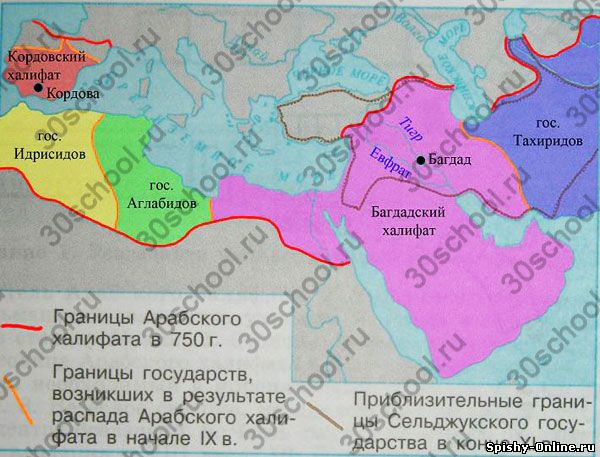
Task number 3.
What or who are we talking about: the territory of the initial settlement of the Arabs, the Arab state on the Iberian Peninsula, the hero of the tales "A Thousand and One Nights", the opponents of the Arabs in the Battle of Poitiers, the river on which the capital of the Abbasid Caliphate was located?
1. Territory of the initial settlement of the Arabs. Arabian Peninsula.
2. Arab state on the Iberian Peninsula. Mordovian Caliphate.
3. The hero of the "Thousand and One Nights" fairy tales. Harun al-Rashid
4. Opponents of the Arabs at the Battle of Poitiers. Franks under the command of Karl Martell.
5. The river on which the capital of the Abbasid Caliphate was located. Tiger.
The tax was introduced by Copts, who staffed the tax bureau at all but the highest levels. For the mass of the inhabitants, the conquest must have made little practical difference, because the Muslim rulers, at least in the beginning, left them alone while they paid their taxes; if anything, their party might have been a little easier because the Byzantine religious persecution was over.
They chose the strategic apex of the triangle formed by the Nile Delta, which at that time was occupied by the Byzantine fortified settlement of Babylon, as the site for this city. They named the city, which is probably an Arabicized form of the Greek term for "camps" and gives a good idea of the nature of the earliest settlement. However, the Arabization process was slow and gradual. Arabic did not displace Greek as official language until 706, and there is evidence that Coptic was still used as a oral language in Al Fushnai.
Task number 4.
Write the dates of events from the history of the Arabs: the Arab invasion of the Iberian Peninsula, the seizure of Baghdad by the Seljuk Turks, the Hijri, the agreement between the nobility of Mecca and Muhammad, the Battle of Poitiers, power passes to the Abbasid dynasty. In the boxes, put down the numbers of the points in time sequence.
1. The invasion of the Iberian Peninsula by the Arabs in 711.
2. The seizure of Baghdad by the Seljuk Turks in 1055.
3. Hijri 622.
4. Agreement between the nobility of Mecca and Muhammad 630.
5. Battle of Poitiers 732.
6. Power passes to the Abbasid dynasty 750.
Dates in sequence: 3, 4, 1, 5, 6, 2.
Given the lack of pressure from the conquerors, the spread of their religion should have been even slower than the spread of their language. A mosque was built in Al-Fushnai with the name "Amr ibn al-A" and every quarter of the city had its own smaller mosque. The Emperor's Mosque served not only as the religious center of the city, but also as a place for certain administrative and judicial activities.
Although Alexandria was maintained as a port city, Al Fushya, built on the banks of the Nile, was itself an important port and remained the same until the 14th century. Arm increased the commercial importance of the port by clearing and reopening the Trajan Canal so that grain shipments destined for Arabia could be sent from Al Fushna to the Red Sea by ship rather than on a caravan.




